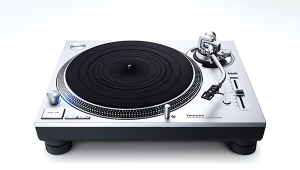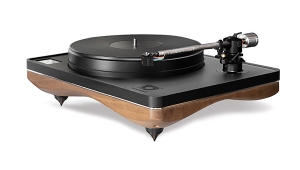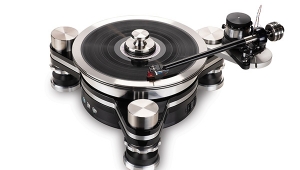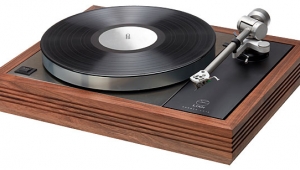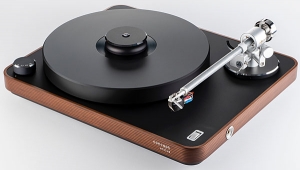| Columns Retired Columns & Blogs |
Linn Sondek LP12 turntable with Lingo power supply
What did you on your wedding night? I know what I did. All three times. But Casey McKee? He spent his wedding night at the end of October installing the new Lingo power supply on his Linn LP12. I know. I was there.
Footnote 1: 10 years after, Casey runs his own specialty audio store in Austin, Ne Plus Ultra. Tel: (512) 241-0000. Fax: (512) 418-1504.—John Atkinson
You remember Casey. You met him in my September 1990 review of the ArchiDee turntable table. Casey works at Brooklyn dealer Innovative Audio (footnote 1); he and wife Angela live in Austin. No, not Austin, NY. Austin, TX! Yup. A long commute. (Buy American Airlines stock. Casey flies American.)
It wasn't as bad a case of Audiophilia nervosa as it sounds. Car-racing enthusiast Casey had persuaded Angela that the most suitable place to spend a honeymoon was Adelaide, Australia—the same weekend as the final 1990 Formula One Grand Prix. And as it wasn't possible to leave for the Antipodes until the following morn, why shouldn't the fellas listen to a few sounds while the ladies oohed and aahed at the wedding gifts. Thus it was that I sat, jaw on my chest, at the difference Linn's new Lingo power supply made to the sound of a fully loaded LP12.
But, as always, I'm getting ahead of myself. Take a minute to refill your glass of Veuve Cliquot while I tell you about the latest installment in Linn Products' master plan to achieve analog domination.
331/3 and 45
So what is the magical Lingo?
A synchronous motor runs at a speed governed by the frequency of the AC voltage supplied to it. Such a turntable motor that is fed straight from the wall voltage, as was the pre-Valhalla LP12, is therefore subject to the frequency vagaries of your local power company, as well as to the presence of any noise on the line. Using that wall power to feed a circuit dedicated to producing a high-purity, low-jitter drive signal is therefore an obvious step forward.
The Valhalla board was Linn's first attempt to achieve this object. It worked well, giving a noticeable improvement in clarity without diminishing the turntable's soul. According to Paul Messenger of the English magazine Hi-Fi Choice, Linn tried to replace the internal Valhalla with an external power supply, the "Wakonda," a couple of years back, but this didn't go into production, it not being felt to offer any sonic improvement.
The Lingo, however, is a different kettle of silicon. Constructed on a single well-stuffed circuit-board running the full depth of its aluminum chassis, the inside of the Lingo looks more like a power amplifier. Which is what is is: a power amplifier intended to deliver a high-purity 120V 50Hz sinewave to the turntable's synchronous motor. In fact, it delivers two sinewaves. Whereas the Valhalla board delivered a single drive signal to the motor, with the second-phase signal derived by a capacitor, the Lingo synthesizes both phases of the supply voltage. The Lingo also offers something that we Linn owners who have collections of 12" singles have been begging for over the years—a 45rpm speed. Yes, there was always the pulley adaptor to enable the LP12 to run at 45, but this was at best a kludge.
The heart of the Lingo is a low-jitter crystal oscillator derived from that used in the ultra-expensive Numerik A/D-D/A processor that Linn Products developed for the pro-audio industry. The high-frequency output of this oscillator is divided down to 50.0Hz (for 33.33rpm) or 67.5Hz (for 45) by conventional TTL chips, and the low-frequency signal is filtered and shaped to give a spectrally pure, low-noise, low-jitter sinewave. This is then amplified to 120V and fed to the turntable.
Modification of an existing LP12 to run with the Lingo is straightforward, but is best left to your Linn dealer. (He or she can give the suspension a tune-up at the same time.) The Valhalla board is removed, along with the ball thrust-bearing under the motor. The traditional, single-LED push switch is replaced with one carrying two LEDs, one red, one green, and the new umbilical, terminated in a spring-locking 8-pin plug, replaces the AC cable.
Footnote 1: 10 years after, Casey runs his own specialty audio store in Austin, Ne Plus Ultra. Tel: (512) 241-0000. Fax: (512) 418-1504.—John Atkinson
- Log in or register to post comments
